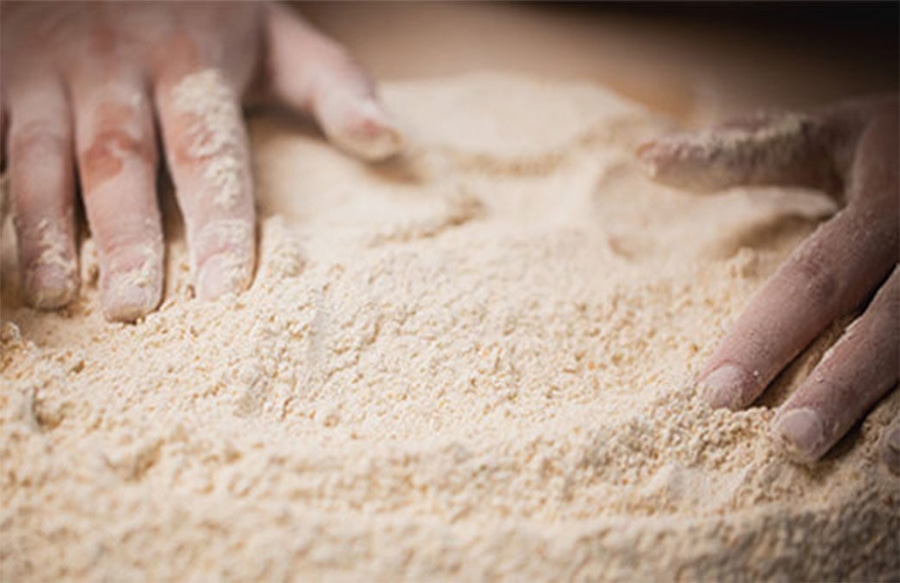
#Industry News
Discover 10 alternatives to wheat flour!
Corn flour, buckwheat flour, millet flour, chestnut flour, chickpea flour, quinoa flour, spelt flour, potato starch flour, rice flour, lentil flour... The alternatives to wheat flour!
Wheat Flour
We have two types of wheat: soft wheat and hard wheat.
Soft wheat is a rather small and opaque grain, primarily used for flour and bread.
Hard wheat, on the other hand, is longer and translucent. It is typically used for applications such as pasta and semolina.
White flour is a basic component of many foods we consume. Unlike white flour (type T45, T55, T65, T80), wholemeal flour (type T110, T150, T170) retains most or all of the cereal's outer layer, also known as bran.
Wholemeal flour is thus an important source of fiber, iron, and vitamin B, essential for the body's proper functioning. It can be found in stores, often in organic form. In terms of practicality, it can be used in the same way as white wheat flour to make biscuits, waffles, cakes, pancakes, etc.
Corn Flour
Corn can be found as flour, semolina, or starch, depending on its fineness. This flour, rich in starch and gluten-free, is appreciated for its neutral taste, making it easy to pair with various foods. Corn flour is characterized by its slightly yellow color, which it imparts to different preparations. This flour has health benefits; it is rich in proteins, calcium, iron, and fiber, providing the energy needed for a full day while being low in calories.
Buckwheat Flour
Buckwheat flour, also known as black wheat, is rich in fiber, protein, and antioxidants. This gluten-free flour has a very distinctive taste. Its dense texture and pronounced flavor may require mixing with other, more neutral flours. Its low glycemic index allows people monitoring their blood sugar levels to consume it.
Millet Flour
Millet flour, originating from Africa, is excellent for health. Rich in carbohydrates, vitamins, and minerals, it is a good source of nutrients. It is highly digestible and therefore well-tolerated by specific diets. This gluten-free flour can be combined with a neutral flour to soften its distinctive taste.
Chestnut Flour
Less known, chestnut flour is gluten-free and rich in fiber and minerals. It also provides numerous other benefits to the body. It offers slow sugars for energy throughout the day. This flour has a dense texture. It can be used alone or mixed with other flours, although it is not suitable for bread-making unless combined with other flours.
Chickpea Flour
A true health asset, chickpeas are also available in flour form. Chickpea flour is an excellent source of protein and a wheat flour alternative. This gluten-free flour is highly appreciated for its fluid consistency and ease of use.
Quinoa Flour
A very important source of protein and fiber, quinoa is also appreciated by people intolerant to gluten. In flour form, it has a slightly bitter taste, so it is recommended to mix it with another gluten-free flour.
Spelt Flour
Spelt is a wheat cousin. This cereal family consists of two types of grains: large spelt and small spelt, also known as einkorn. Large spelt is an ancient variety of cereal, distinguished by its high protein content. However, the flour contains gluten, although its content is lower than that of wheat. Rich in nutrients, spelt flour contains proteins and amino acids that are essential for our bodies. Large spelt flour can be used for baking. It is called the anti-stress flour because it is richer in proteins, as well as magnesium, zinc, iron, and copper than wheat flour. Its taste is more subtle than that of small spelt flour. Small spelt, also known as einkorn, is an alternative to wholemeal flour. It is one of the few cereals to possess all 8 essential amino acids. Moreover, this cereal is low in gluten, making it suitable for people intolerant to gluten. This ancient variety of cereal will be particularly appreciated by those who seek the rustic flavor offered by ancient varieties, adding a gourmet touch.
Potato Starch Flour
Starch corresponds to the starch present in the plant; it is extracted from potato tubers. Rich in starch and gluten-free, it is lighter than flour. Once reduced to flour, it is used to thicken sauces, for example.
Rice Flour
White rice flour, rich in starch, is obtained from refined rice grains. It is one of the most commonly used gluten-free flours due to its neutral taste. Fluid and light, it is crumbly and therefore needs to be combined with one or more other flours to obtain a satisfactory texture. It is preferable to combine two gluten-free flours to replace wheat flour. Its glycemic index is high, which is why it is not recommended for people monitoring their weight and/or blood sugar. It is often used as a substitute for wheat flour by those who are gluten intolerant. The advantage of rice flour lies in its perfect combination with all other flours. Whole rice flour is more nutritionally interesting than white rice flour and provides a slightly pronounced taste. It can be used in the same way as white rice flour, but its less neutral taste will give it more character.
Lentil Flour
Lentils are a legume naturally gluten-free. Consequently, lentil flour is a very good alternative to wheat flour as it is a gluten-free flour rich in fiber. This flour provides the energy needed by the body throughout the day.







